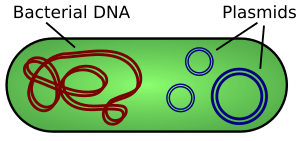Plasmid facts for kids

A plasmid is a DNA molecule that is separate from the chromosomal DNA and that can replicate (copy itself) independently.
The term plasmid was first introduced by the American molecular biologist Joshua Lederberg in 1952.
Plasmids are double stranded and, in many cases, circular. Plasmids usually occur naturally in bacteria, but are sometimes found in eukaryotic organisms (e.g., the 2-micrometre-ring in Saccharomyces cerevisiae).
Plasmid size varies from 1 to over 1,000 kilobase pairs (kbp). The number of identical plasmids within a single cell can range from one to thousands. Plasmids are often associated with conjugation, a mechanism of horizontal gene transfer.
Plasmids are transferable genetic elements, or "replicons", capable of independent self copying in a suitable host. Plasmids can be found in all three major domains, Archaea, Bacteria and Eukarya. Similar to viruses, plasmids are not considered a form of "life" as it is currently defined. Unlike viruses, plasmids are "naked" DNA and do not encode genes necessary to encase the genetic material for transfer to a new host.
Plasmid host-to-host transfer requires direct, mechanical transfer by conjugation or changes in host gene expression allowing the intentional uptake of the genetic element by transformation.
Microbial transformation with plasmid DNA is neither parasitic nor symbiotic in nature, since each implies the presence of an independent species living in a commensal or detrimental state with the host organism. Rather, plasmids provide a mechanism for horizontal gene transfer within a population of microbes and may provide a selective advantage under a given environmental state.
Plasmids may carry genes that provide resistance to naturally occurring antibiotics in a competitive environmental niche, or alternatively the proteins produced may act as toxins under similar circumstances. Plasmids also can provide bacteria with an ability to fix elemental nitrogen or to degrade difficult organic compounds. This may provide an advantage under conditions of nutrient deprivation.
Images for kids
-
Electron micrograph of a DNA fiber bundle, presumably of a single bacterial chromosome loop
See also
 In Spanish: Plásmido para niños
In Spanish: Plásmido para niños



